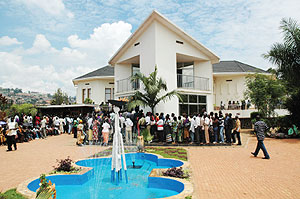The best place for one to come to terms with the harrowing history of Rwanda and how it came about and even why it must never happen again is right here at home in the Kigali Genocide Memorial Center located in Gisozi.


The best place for one to come to terms with the harrowing history of Rwanda and how it came about and even why it must never happen again is right here at home in the Kigali Genocide Memorial Center located in Gisozi.
Here the remains of many of the one million dear souls that departed from this earth brutally are buried and in their remembrance is a sorrowful but insightful journey through the history of Rwanda that every Rwandan and every person who thinks or feels that a genocide should never take place on earth ever gain, has a responsibility to take.
Inaugurated in 2004, the museum is a miniature walk through the history of Rwandan people. Presented in clear images, easy to use visuals and with very informative and helpful guides in Kinya-rwanda, English and French, we are taken back to the roots of Rwanda’s tragic history, without bias towards any particular group and with clear intent to inform and educate.
The site is divided into different units like: exposition rooms of genocide proofs, a documentation centre and an education centre for peace and reconciliation.
Oral testimonies reverberate from different quarters of the site as well as factual information on the walls presented in a clear and coherent manner. Apart from these are human bones, and skulls that have been treated for conservation.
Weapons used during the genocide like machetes, clubs, swords are displayed. Also rosaries, identity cards, shoes, clothes, and pipes, abandoned by victims are there.
As a museum of the genocide, the memorial accomplishes the basic curiosity of what, how and why it happened.
To those who would like to relive those moments albeit with caution, the museum is a place of serene solace, where one feels at peace with themselves and the questions that continue to dodge oneself, as to how such a thing would happen, complete with examples from other genocides or similar cats in other parts of the world.
It puts in perspective the different players and seeks to give. To those who were not here but cannot comprehend why men would do such inhuman acts to other men, the site is a graphic and a logical trip through time.
More importantly, the memorial site seems to seek some sought of closure to the horrific chapter in Rwanda’s history, however difficult and is also a brave attempt to dwell in history and lessons from the future.
It is a symbol of the Never Again philosophy and it seeks to explain how that is possible and how the philosophy can be engrained in the fabric of future generations, not only in Rwanda but the world in general.
The site is easily accessible by any means of road transport within Kigali city and is a focal point during this Mourning week in Rwanda as various groups of people visit to remember the lost loved ones and learn from history.
Ends


